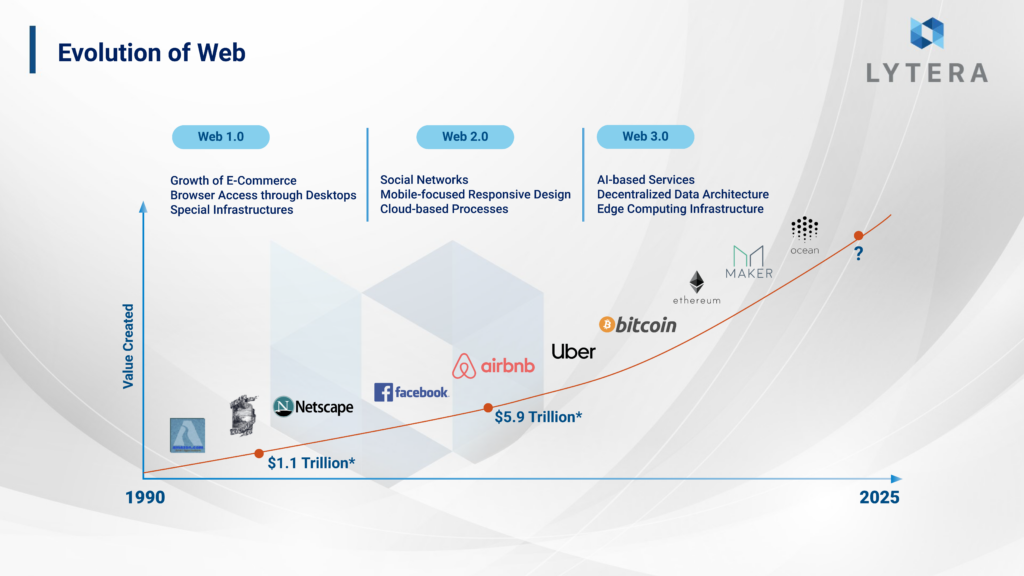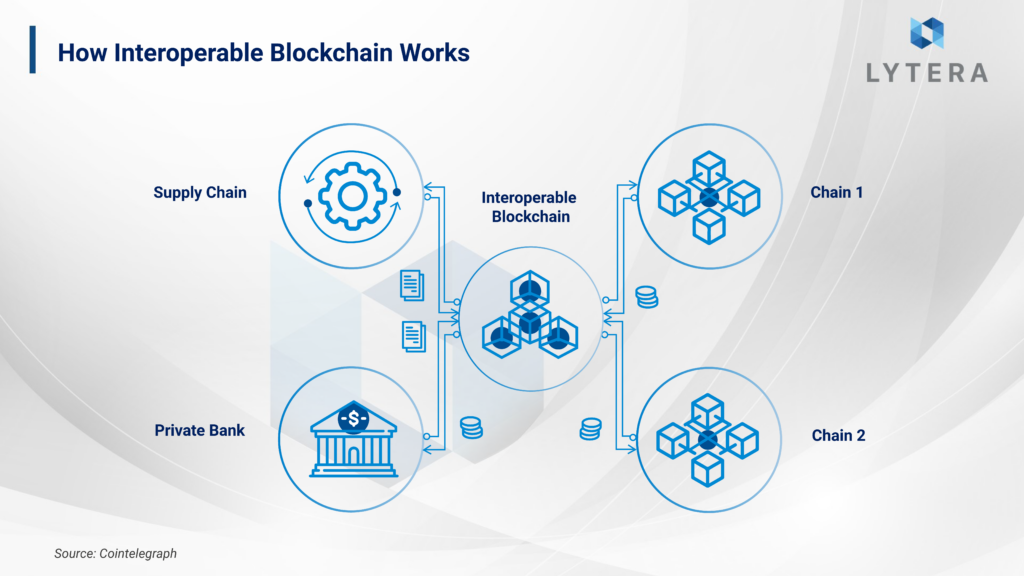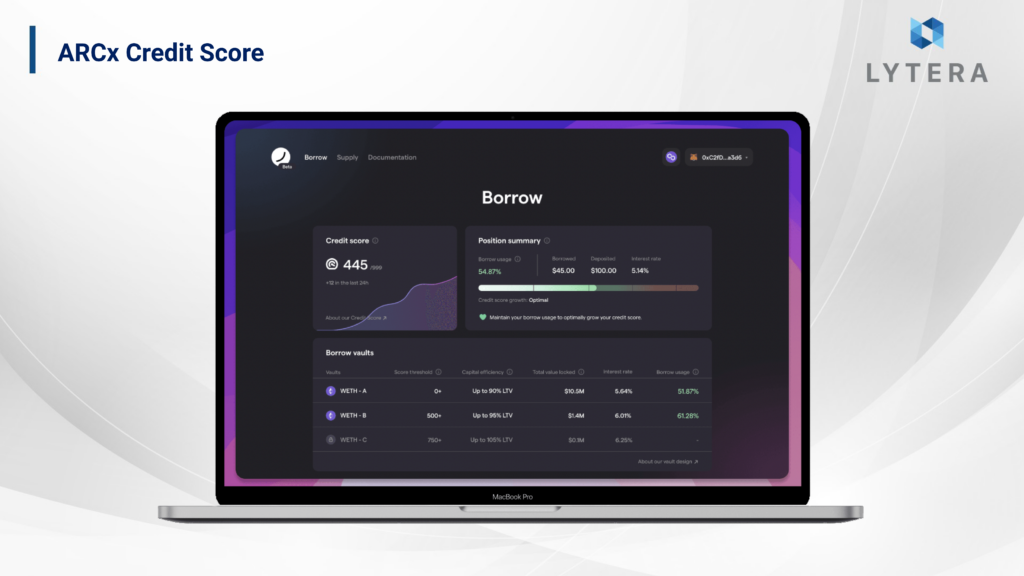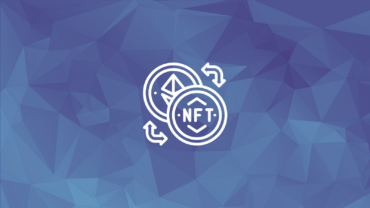- In terms of identity and data concepts, the greatest contribution of Web3 is to allow us to take full control of these areas unlike Web2.
- We will not only be able to solve the existing problems of Web3 on Web3, but also carry out our activities more efficiently with the interoperability principle.
- “your data, your money.”
- With a financial document identity that can be created on top of DeFi protocols, we can ensure capital efficiency for projects, and collateral efficiency for users.
- Recently, rather than financial instruments, projects focusing on social aspects have begun to emerge on blockchain. For instance, ACRx Money is working on creating a DeFi credit score on Polygon.
- With the involvement of both the public and private sector into Web3 ecosystem in the mid to long term, we may eliminate tedious bureaucratic processes with a single transaction using our wallet.
What is Web3
The concept of Web3 has recently become the main topic of discussions. Although it is not too long ago that it entered our lives as a new term, the philosophy and structure behind it is actually an order that we are already familiar with. It would not be wrong to define Web3 as a general structure/term where interrelated subjects such as cryptocurrencies, blockchain, decentralization and autonomous structures come together. Three basic criteria constituting the core of this structure are decentralization, privacy and interoperability. Even with the absence of one of these criteria, the massive structure we call Web3 will not be possible to operate.

Since it has a permissionless structure, anyone can manifest themselves in various areas within the ecosystem. This opportunity to manifest oneself may appear as a developer or as a consumer. In a scenario where we are only the consumers in this field, we leave our traces with many projects and actually share our valuable data with the protocols.
Identity Definition
While talking about identity, we initially think of solid documents where critical information is written on such as identity cards or driver’s license, this concept is in fact the sum of all the details in the life of an individual. Everything from the city where we were born to our favorite music bands, from the platforms that we use to the accounts we follow eventually creates our identity. Although in real life, this identity is mostly known by our close circle, we may be followed by many people and platforms that we do not know in real life on social media, and an identity can be formed through the cookies we leave on the internet. At this point, our unique identity is actually transformed into information and data. Every transaction we sign, every song we listen to, every video we watch, all the information about us are stored by platforms that we use, and this information is transformed into a profit mechanism by these platforms.
Web2 – Data and Identity Definition and Problem
The world of the internet that we are currently in is defined as Web2, which can be regarded as a platform economy. Within this platform economy, we can produce content, watch it, read it, and make an income through communities with our content in many content-oriented social media applications. As we know, almost all social media applications currently provide these services “free of charge”. However, it is essential that we understand there is a profit mechanism behind all these “free” services within the economic spectrum we are in as these applications are not NGOs.
We have already mentioned that each trace we leave on the internet are turned into data, and the platforms that we use store this data. So, why do they store this data? The answer is simple: To make profits off of the users by selling the data to other companies who need it. Data sold here is used to create a market for another company and to optimize advertising efforts. For instance, let us assume you need a new phone and you start checking phones on a well-known marketplace website. This website saves your information and shows you phone ads linking to its own website on different websites based on the cookies they collect. Let’s say you notice something from these ads on other websites and you decide to click on the ad. Afterward, what you will most probably encounter will be to be served phone ads from other marketplaces.
The greatest problem with identity on Web2 is that individuals do not have control over their own data, and the institutions making profit over this data are actually the “free” applications that we use every day. One of the most common phrases we kept hearing in the crypto ecosystem was “not your keys, not your coins” or “not your wallet, not your money”. However, the ecosystem is no longer just about peer-to-peer (P2P) money transfer or lending/borrowing protocols. At the same time, the ecosystem keeps producing new projects that will enable the individuals to take control in their own hands in all areas of life. Perhaps, the phrase that we will keep hearing will become “your data, your money”.
Web3 – Importance of Data and Identity (Interoperability)
Thanks to Web3, we have the chance to get rid of the problems that are inherent in Web2. Our wallets, the atomic units of Web3, are the books recording all activities on-chain and keeping the information of this data. Wallets, currently giving us the opportunity to store our money in our own pockets instead of with third parties, also provide us with our information data. Although they currently hold basic information such as financial documents, our preferences in art and governance activities, we have the potential to process and store many different data in the future with the development of the ecosystem. Additionally, even now, the data stored enables individuals to direct their identities and individualities on-chain as they wish. To illustrate, let us assume you have been active in the community since the beginning of Project X, taking part in discussions and participating in governance votes. Many projects tend to match wallets with their community members through their existing communication channels. In such a scenario, all the activities you do on-chain or off-chain are recorded, and people can still get an idea about your individuality by checking your wallet. During this time, your interest started to shift towards Project Y, and you decided to do some activities to improve the community and the project through communication channels. And you want to take things a little further for Project Y, want to become part of the project, not just the community. In such a case, the fact that your wallet keeps your on-chain activities becomes an indicator both as your active involvement in communities and acts as a proof of humanity. In other words, it makes it easier to freely navigate in the ecosystem both for the individual and for the projects.

The feature of interoperability that we mentioned at the beginning of this article is a key feature for Web3 and Identity. Interoperability basically refers to the ability of multiple blockchains to communicate with one another and safe transfer of data/tokens between two different chains. This feature enables the communication that allows an individual to swap ETH token on Ethereum network with USDC on Avalanche network. Although the communication between different blockchains hasn’t been implemented in a user-friendly manner with a greater scope, right now, it is one of the greatest problems that Layer 1 blockchains are trying to solve. The most commonly used methods for interoperability of blockchains are atomic swaps and relay method.

Going back to the subject of on-chain data and identity, it wouldn’t be wrong to say that individuals using decentralized financial instruments or NFT collectors are not doing everything on a single chain. Our data accumulates on many different blockchains to get the maximum benefit as both opportunities and protocols may appear in different forms across different chains. If we were to spend the effort on a single chain, we would not have an identity across different blockchains and would have a narrower market for our data that we can make revenue in the future. The principle of interoperability gives us the right to have a presence on multiple chains with a single wallet, allowing us to have tighter communication with the ecosystem.
In a world where the entire Web3 realm is interconnected, we will have the opportunity to access all public and private sector applications existing in the ecosystem with a single wallet thanks to the principle of interoperability.
Web3 – Data/Identity Fields
On Web3, we can exist with multiple identities, not only with our financial data. If we assume that institutional companies or even states will participate in this ecosystem in the future, we can say the doors of opportunities will keep opening. Let us discuss these in different categories.
Personal Data & Identity Ownership
In a world where blockchain becomes part of our daily life, we can process our personal data that we prefer or have to keep (for instance, business cards, fingerprints, etc.) in a smart contract with a wallet to keep them all in one place. Similarly, title deeds of immovable properties may be purchased on a blockchain and can be used to accelerate bureaucratic procedures in case of a property sale/exchange. Moreover, we can store documents required to do a job or apply for a job in both government procedures and private sector, and can easily fill out the relevant forms automatically just by connecting our wallet through their platforms of these institutions.
Collateral
Currently, one of the most used products in the crypto ecosystem are borrowing/lending protocols. Many of these protocols serve through “over-collateralization” method. In other words, users need to deposit more collateral than they can borrow so that the system does not suffer losses as it works using smart contracts. It may be possible to change the collateralization scales for the next transaction by creating a financial credit score on crypto platforms based on the repayment of debt (early, late, or liquidation) just like the loan procedures of banks in real life based on the credit scores of customers. ARCx Money project, which will be discussed later in the article, designs a project on creating a credit score on decentralized finance. Considering that DeFi holds the highest share in the crypto ecosystem, it is possible to expect the development of such new systems in the future.
Transaction
Every transaction we make on the blockchain is recorded on distributed ledgers and all our transactions can be followed transparently. One of the biggest problems faced by projects in their decentralized structure is sybil attacks. For example, a project wants to mint tokens to decentralize its governance and distribute it in a fair manner to its community. People, with the expectation that the project may follow such an approach, may exploit this situation by using many sybil wallets. To prevent this, projects may benefit from wallet activities or the transactions may provide a proof of humanity. For now, it is both a bit difficult and complicated to implement this process. However, a decentralized identity project which would be defined on blockchain to record certain milestone points by tracking transactions (transaction X on Protocol Y, etc.) may create a sybil resistance network within the ecosystem.
Data
The fundamental factor that we have been discussing since the beginning of the article is that individuals should be able to keep control of their own data and use it as they wish. As the number of Web3 applications increase and as people use these applications, a huge amount of information data will accumulate on the wallet that we use. While normally this data is stored on company databases or servers, it will now be in our wallets that we can access. Moreover, in addition to the data recorded on the wallet, we will also have the opportunity to tokenize various data types to transfer them onto the blockchain. In this way, we will be able to take full control of our data and share this information with the only parties that we wish to share.
Social
We also have the opportunity to design the familiar social media identity on Web3. Recently, apart from financial instruments, many social media products have emerged on blockchains, which provide various features on a single platform. The clear difference between the social media tools on Web3 from those on Web2 is probably the ability of the users to make revenue through their own identity without any intermediary.
Moreover, some applications have started to enable connecting NFTs via people’s wallets for them to verify themselves as part of the transition from Web2 to Web3. Probably the best example of this can be seen on Twitter. Anyone who wishes can change their profile picture on Twitter with an NFT by connecting their wallet. This not only enables individuals to follow the proof of humanity principle on Twitter, but also helps them indicate that they belong to a different community as the NFT profile pictures are not round but square.
One of the greatest criticisms of NFTs is that these things can be easily copied. And we have seen many scammers trying to take advantage of this situation. Decentralized identities will grant the artists the privilege to have a unique signature on their work, allowing original NFTs to be distinguished from copy works.
Web3 – Projects Working on Identity
ARCx – Defi Passports – DeFi Credit Score
ARCx credit protocol introduced a new application called Defi Passport last year. And the purpose of this app was to create a score table for wallets based on specific occasions. The main idea behind this was to implement a similar feature to credit score that’s held by banks in real life to decentralized finance. Among these passports are criteria such as holding prominent Airdrop tokens in the wallet. Last week, they took things a little further to implement Defi Credit Score in a closed beta on Polygon to directly integrate it into these passports.
The main starting point for this app is to maximize capital efficiency in current DeFi platforms both for the projects and the users. This credit score plans to increase the limits of the user in decentralized finance by becoming an identity/a financial document for wallets. The metrics used by the project, planning to measure on-chain activities with 3 methods to create the scores, are daily score reward, no liquidation based on 120-day data reward, and liquidation penalty.

In the future, if this product collaborates with different DeFi protocols, people’s on-chain financial identities will start to have a function, and the users will be able to find incentives that benefit them on collateralization scales, mentioned above.
Decentralized Identity Foundation (DIF)
Decentralized Identity Foundation is a non-profit organization working on subjects such as decentralized identity definition, use, development and communication facilitation within the industry on Web3. Together with many partners both inside and outside the ecosystem, they are working on wallet security as the atomic unit of Web3 identity and to create a new DID Authenticator (Decentralized Identity Auth).
The great motivation for the emergence of the foundation could be seen as capturing a common denominator for decentralized identity on Web3 without the need for central authorities. One of the most important points here is that DIF aims to develop these applications not only for individuals but for institutions and projects. In other words, they are working for an ecosystem based completely on decentralized identity. To enable this, they have been developing a Universal Resolver on interoperability for more than five years.
Disco
Disco, being developed under the leadership of Evin McMullen, aims to create an identity that individuals can use on all blockchains and dApps. The main advantage that Disco provides to the users is allowing you to collect your data, accounts or passwords in a single layer and to provide the information you would like to show to others in a way that you can restrict access to certain data. With this layer, you will be able to fill out the application form without exposing all your data, while saving time, by pre-defining the information that you want to share while applying for a job through a single channel.
Lens Protocol
Lens protocol is a blockchain ecosystem deployed on Polygon to enable the development of decentralized social networks. Lens Protocol makes a difference in the current ecosystem to recreate social media and our identities on social media on Web3. Many applications such as Phaver, Lenster, Lensfrens have been developed on top of it, and these applications were launched with a revenue mechanism in line with the philosophy of Web3.

Conclusion
In addition to financialization, probably the biggest benefit of the Web3 ecosystem is allowing us to take control of our data, and enabling us to build our identity in a more secure and accessible manner both in financial and social terms. Due to security vulnerabilities in applications we use in daily life that we have frequently seen recently, many of our personal data are seized by malicious actors and shared in dark markets. This situation obviously results in people losing their trust in current companies and institutions. It seems that blockchain technology will be the only solution to overcome this distrust.
In addition to security, we will be able to freely and easily make transactions in the digital world after ensuring the principle of interoperability, which we have broadly discussed throughout this article. Just as an example, a student applies to many universities for a master’s degree after getting their bachelor’s degree. Many of the documents requested for the application for a master’s degree are the same for almost all universities while the number of different documents only constitutes a smaller portion. In the current scenario, the student has to upload the same documents over and over again while applying to different universities. However, in a system where universities adapt to Web3 technologies, we will have the opportunity to store necessary documents on the blockchain and to send all these documents in a single transaction just by connecting with our wallets. Some universities around the world and in Turkey have started to give diplomas of top students of their departments or faculties as an NFT. This first move raises our hopes that universities, the source of knowledge for the future, can be the guide to lead the way.
Apart from education, especially considering the increase of financialization and that this increase is mostly achieved through crypto markets, decentralized finance documents/identities can be seen as an improvement that can both allow users to make transactions more securely and reduce the risk exposure of projects. One of the biggest challenges that DeFi has been facing, the difficulty for protocols to reach the end user, can become accessible with this new structure and may pave the way for decentralized financial organizations and next generation collateralization structures in DeFi.
Although there are only private companies and projects in the ecosystem, I believe governmental institutions will inevitably participate in this system, or launch their own semi-decentralized identity-based products in the worst case scenario. Especially in Turkey, it is possible to follow certain bureaucratic procedures through the e-devlet (e-government) platform and it is seen that different institutions are increasing the number of their digital products day by day. A Web3-based e-government structure can become a product that is likely to be in our lives in the mid-to-long term although not very likely in the near future, which will enable us to handle some of the above-mentioned procedures without the troublesome processes or the need to use intermediary institutions.




